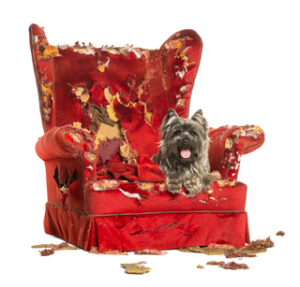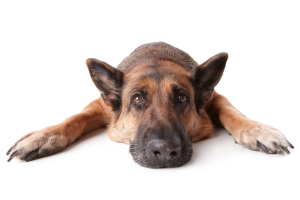 Since dogs are social animals, they love to stay connected to others. It shouldn’t be a surprise to us then that when they’re left alone, many become quite anxious and long for our return. But for some dogs, being alone isn’t just a matter of longing with a tint of worry. They’re experiencing anxiety and sometimes even a full-blown panic attack. Those dogs might whine and bark during the entire time they are left alone. They might eliminate in the house even if they’re otherwise potty trained. In extreme cases, they can drool continuously, become anorexic, attempt to escape by digging their way out of their crate or house or they can become depressed or self-mutilate. We’ve touched on this subject in a previous post “Separation Anxiety in Dogs – A Consultant’s High Tech Toolkit” and explored ways to diagnose and treat this distressing condition. But up until recently a question remained unanswered: why do some dogs develop separation anxiety when others don’t? What are the factors that lead dogs to develop such symptoms? A new study from a Norwegian research team, on over 200 dogs with separation anxiety can help us understand the causes of such fear and agitation from being left alone (Storengen & al., 2014).
Since dogs are social animals, they love to stay connected to others. It shouldn’t be a surprise to us then that when they’re left alone, many become quite anxious and long for our return. But for some dogs, being alone isn’t just a matter of longing with a tint of worry. They’re experiencing anxiety and sometimes even a full-blown panic attack. Those dogs might whine and bark during the entire time they are left alone. They might eliminate in the house even if they’re otherwise potty trained. In extreme cases, they can drool continuously, become anorexic, attempt to escape by digging their way out of their crate or house or they can become depressed or self-mutilate. We’ve touched on this subject in a previous post “Separation Anxiety in Dogs – A Consultant’s High Tech Toolkit” and explored ways to diagnose and treat this distressing condition. But up until recently a question remained unanswered: why do some dogs develop separation anxiety when others don’t? What are the factors that lead dogs to develop such symptoms? A new study from a Norwegian research team, on over 200 dogs with separation anxiety can help us understand the causes of such fear and agitation from being left alone (Storengen & al., 2014).
What do we call separation anxiety (SA)? If a dog that never potties in the house when you’re at home, regularly soils the carpet when you’re gone, more than likely, your dog has separation anxiety. Unless of course you were gone for so long that he couldn’t hold it anymore. In the same way, if your dog is generally quiet and may let out an occasional bark when people knock at the door, but starts barking incessantly the minute you leave, your dog has separation anxiety. In short, when dogs behave in ways that are different than typical when we’re gone, chances are: they are in distress and may have separation anxiety. Dogs may chew, dig and scratch, typically at exit doors and windows or gates. They may chew or tear apart specific objects or furniture. But these are the obvious signs, the ones you find when you come home or when the neighbor complains of the excessive barking. When dogs with separation anxiety are video taped, they never play when the owners are gone. Instead, in addition to all the behaviors above, they also show signs of distress such as lip licking, yawning, panting or pacing that most of us stay unaware of because they don’t leave marks (Palestrini & al., 2010).
Amongst all the different ways dogs express their distress when left alone, barking seems to be the most common symptom. We can see where many guardians may be tempted to resort to bark collars to stop this behavior, but treating distress with an aversive will only backfire. We may get temporary relief as the dog inhibits the barking, at least at first. But over time, the anxiety, now coupled with the possibility of discomfort will come out in other forms. We just can’t treat fear with punishment. Even a mild vibration would just make it harder on the dog. I was recently called for help with a dog that could not be walked any more. The dog was adopted a few months ago and was then very friendly and happy to go for neighborhood walks. But one day, as his guardians came home, the neighbor told them that their dog had been barking anytime he heard a sound. This was a major problem since the couple and the neighbor lived in a duplex and the neighbor was working from home. So the couple decided they had to do something fast and a bark collar seemed like the best option. But what happens when a dog that sensitive to the sights of sounds of people around the house gets punished every time he barks? He may learn not to bark, but what has he also learned about people around the house? To a sensitive dog, it doesn’t take but a few times to learn that people around are bad news and he may not bark when the collar is on, but he’ll now show fear/aggressive reactions towards people as soon as he steps one foot out of the house.
 So what causes SA? It was often suggested that SA was linked to over-attachment of the dog to the guardian. The more recent studies show however that there may be more to it and that SA can also develop from a number of other factors. Separation anxiety can have genetic factors, but can also be caused by environmental reasons or both:
So what causes SA? It was often suggested that SA was linked to over-attachment of the dog to the guardian. The more recent studies show however that there may be more to it and that SA can also develop from a number of other factors. Separation anxiety can have genetic factors, but can also be caused by environmental reasons or both:
- Certain breeds seem to be more susceptible to SA, such as Cocker spaniels, Schnauzers and Dachshunds suggesting that SA can have a genetic predisposition (Storengen & al., 2014).
- Male dogs seem to be more prone to separation anxiety than females (McGreevy, 2008; Storengen & al., 2014).
- Neutered dogs show a higher frequency than intact dogs (Storengen & al., 2014). Neutering however may not be a cause of SA, but mostly an attempt by the guardians to treat the behavior problem. Neutering however has not shown to improve SA in any way.
- Where and when we adopt a dog has a strong impact on whether or not our dog will develop SA. When dogs were acquired from friends or family, they have a lower tendency to show signs of SA than if bought in a pet store (McGreevy, 2008). It’s possible that the separation from humans to a caged environment may be a factor.
- Now ladies, this is for us: studies show that when more women are present in the house, the dog’s chances of developing SA also increases (McGreevy, 2008; Storengen & al., 2014). Women could relate to their dog in a different way than men, but it’s also possible that we tend to attend to the dog’s needs sooner than our male companions. By doing so the dog could also become more dependent with fewer opportunities to develop healthy coping skills.
- Dogs also seem sensitive to a new person in the household and to their owner going through a change of job (McGreevy, 2008). Any important changes in a person’s life can have a significant impact on the dog.
- Playing or feeding our dog within the first 30 minutes of coming home seems to increase their chance of SA (McGreevy, 2008). In most cases it would be hard to say if the guardian started paying special attention to the dog because of the SA. It’s also easy to feel a little guilty when leaving our pooch at home all day. The consequence though is that the dog develops increasing excitability in anticipation of his person coming home, so he’ll likely jump and vocalize (Storengen & al., 2014). In contrast, the SA tends to be reduced when we provide games and exercise to the dog at other times (McGreevy, 2008). Regular walks can make a significant difference on the dog’s behavior (see blog: Walking the dog has big impact!).
- When the dog shows high levels of excitability, fear and anxiety, the chances that he/she will have SA are also high. On the opposite side of the coin, if the dog is stretching and yawning within the first 5 minutes of their human coming home, that’s a sign that he/she was fairly relaxed while left alone.
- Generalized anxiety also seems to be a predictive factor of SA and most dogs with SA also show signs of noise sensitivity. So if a dog reacts and is easily afraid of noises, or storms, there is a higher chance that he/she will have SA or another anxiety related disorder (Overall & al., 2001; Storengen & al., 2014).
 What can we can we do to prevent this difficult condition? If there is a genetic basis to SA, we’ll need more studies on breed differences to identify which ones are more susceptible than others, but in the meantime, breeders should avoid breeding the dogs with such condition. Most of all, these studies help us figure out strategies to help our dogs feel safer when left alone. Fear can have many forms and affect the dog in different ways (see blog : Treated fear can return – even to the next generation). When we recognize that our dog is fearful of certain stimuli, it’s important to help our dog develop more confidence and not expect him/her to simply grow out of it. SA may just be one of the displays of an overall and more generalized feeling of anxiety. Once the dog shows signs of separation anxiety, working with a behaviorist or trainer is key to any successful treatment. For more information on how to deal with separation anxiety, Malena DeMartini-Price wrote a great book on the subject: Treating Separation Anxiety in Dogs. She’ll also be speaking at the next Pet Technology Conference 2014.
What can we can we do to prevent this difficult condition? If there is a genetic basis to SA, we’ll need more studies on breed differences to identify which ones are more susceptible than others, but in the meantime, breeders should avoid breeding the dogs with such condition. Most of all, these studies help us figure out strategies to help our dogs feel safer when left alone. Fear can have many forms and affect the dog in different ways (see blog : Treated fear can return – even to the next generation). When we recognize that our dog is fearful of certain stimuli, it’s important to help our dog develop more confidence and not expect him/her to simply grow out of it. SA may just be one of the displays of an overall and more generalized feeling of anxiety. Once the dog shows signs of separation anxiety, working with a behaviorist or trainer is key to any successful treatment. For more information on how to deal with separation anxiety, Malena DeMartini-Price wrote a great book on the subject: Treating Separation Anxiety in Dogs. She’ll also be speaking at the next Pet Technology Conference 2014.
Jennifer Cattet Ph.D.


O post é excelente e muito útil pois, decorrente de maneiras incorretas de lidar e educar seus cães, tutores tem ajudado a referida síndrome aparecer em cães que poderiam ser cães saudáveis emocionalmente.
Parabéns !
Does anyone have any ideas on how I could get my male dog with separation anxiety fixed? I tried a dog sitter once and he broke out of the cage and then the house, within 20 minutes. He goes nuts absolutely nuts when I am not around. And it’s no secret as to why. I saved him from extreme physical abuse. I want to get him fixed already, but have no idea how to get it done. I tried telling the vet that I need to be there, but she doesn’t believe me on how bad it is. Neither did the dog sitter, until she saw it for herself. I am open to any ideas short of chopping them off myself 🙂